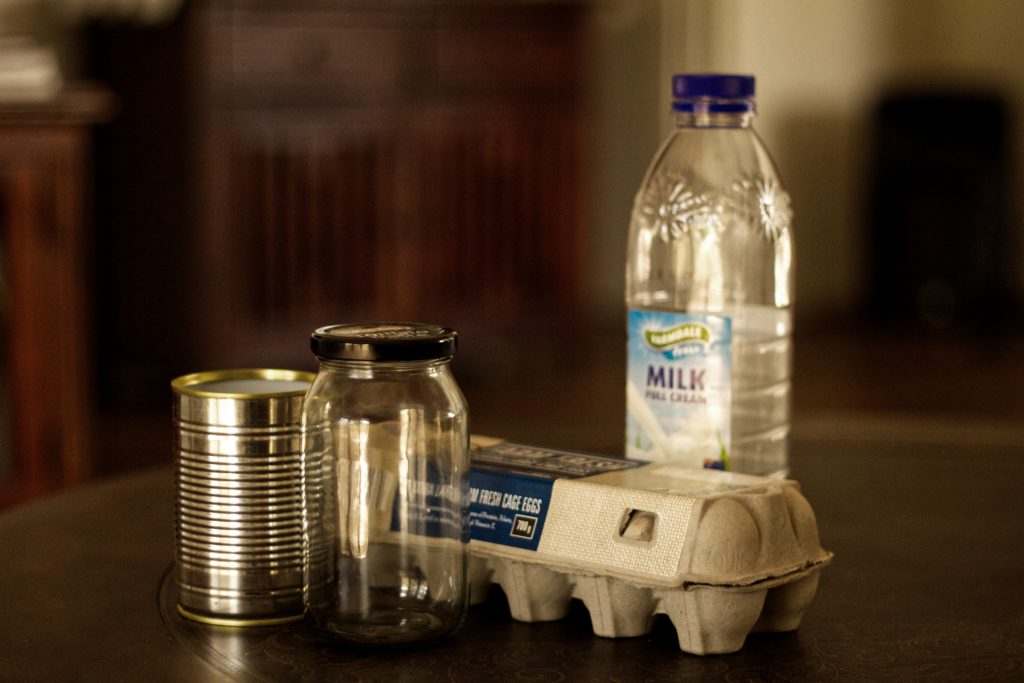Packaging isn’t a new phenomenon. Hence have always used it in some form or another. It’s part of being human. We have always needed some form of packaging to transport, store and protect items.
The history of packaging begins with things that were easily accessible including leaves, gourds, animal skins and hollowed out logs. However as we have advanced though our packaging has become more and more sophisticated. This is particularly the case since the industrial revolution. We’ve put together a timeline with some major packaging materials including the elements that were developed to create them.
Glass
To begin the history of packaging, the first man made package was produced in Ancient Egypt. These were glass water pots. The first glass items were also found in Egypt. These date back as far as 2500BC.
Glass blowing was invented by the Syrians in the 1st Century BC. However by the middle ages Venice had become the major centre for glass making. From there the art of glass making spread all over the world.
America’s glass bottle and glass jar industry began in the early 1600’s in Jamestown when settlers built the first glass melting furnace.
Today glass has many uses in packaging including medicines,jams, spirits, liquids and other high valued goods.
Find out more about the history of glass here.
Metals
Metal has been used for all kinds of things for a very long time. But the first metal used for packaging was tin. The process of tin plating was invented in Bohemia in the 1,200’s.
This process was brought to England in 1667 by Andrew Yarranton and Ambrose Crowley. Then it was improved by iron masters including Philip Foley.
The first packaging items made from tin were tinplate boxes. They were first sold in the Bristol Channel in 1725. Over the next 100 years they became very popular.
Learn more about the history of metal packaging here.
Tinned Food
Tinned food was introduced as a way of preserving food in the early 1800’s after Napoleon was looking for a way to preserve food for his soldiers.
The first cannery was established in London by Englishmen Bryan Donkin and John Hall. Once again, this tinned food was produced for the British Navey.
Tins began to replace glass for drinks in the 1960’s. First it was used for alcohol, but this soon moved to soft drinks. Then tin was replaced by Aluminum. That’s because it was cheaper and lighter.
Finally, Aluminum foil was developed in 1954.
Paper
The earliest recorded use of paper for packaging dates back to 1035. A Persian traveller visiting Egypt noted that many things were wrapped in paper for the customers after they were sold.
However paper was invented long before that. The Chinese developed the art of paper making. Cellulose fibres were extracted from plants and formed into paper. Over time this paper began to be used for transporting food. It didn’t arrive in England until 1310.
Before paper mills were established, paper was made out of parchment and rags. The problem was that these things were in limited supply and expensive.
Printing
Paper lends itself perfectly to printing. However until the end of the 18th century, the only methods available were limited. Lithography was invented in Munich by Alois Senfelder. This process brought greater flexibility and creativity to packaging design as a result.
The effect of the Industrial Revolution on the History of Packaging
The Industrial Revolution brought great change to many things. things that had once been done by hand could now be done by machines as a result. Hence, more product could be made quickly. Furthermore, this lead to a greater need for packaging. Hence, bins for storage and transportation. Bags, primary packaging materials and in-store packaging were also necessary.
Bags & Boxes in the History of Packaging
The first corrugated cardboard box was developed in 1817. Similarly, in 1817 Thomas Gilpin used a cylinder machine for making paperboards and other forms of paper used in packaging. Furthermore, the paper bag machine was developed in 1844. Hence paper was further pushed as a packaging material.
Corrugated paper received a British patent in 1856. As a result, this special form of paper was used as a liner for tall hats.
Railroads Role in the History of Packaging
Railroads began to be developed form the 1860’s to the 1880’s. As a result, he second wave of the Industrial Revolution hit at this time. Hence, trade suddenly flourished. However materials and processes were still expensive at this time. Similarly, producing packaging was very labour intensive. As a result, packaging was mainly seen as a way of storage. Hence, it was reserved for only high value goods. Items like jewellery, gift items, shoes and premium foods were the kinds of things packaged for sale.
Up until this point, all of our packaging materiel was made from natural resourses. Certainly, natural resources were in limited supply. As a result packaging was expensive to make. However the next stage in our packaging history was going to change all of that.
Plastic’s role in the History of Packaging
Plastic is our newest packaging material. There were a range of plastic materials developed in the 1800’s. However these weren’t suitable for packaging.
The first true plastic was created in 1862 by Englishman Alexander Parks. He called his product Parkesine. As a result he won a bronze medal for his achievement. However his product wasn’t initially successful. As a result his company was taken over by Daniel Spill. After that Spill renamed the plastic Xylonite.
Another inventor, John Wesley Hyatt invented a similar product shortly after. He named his product Celluloid, and this product did take off.
End to the Reliance on Natural Resources
The discovery of plastic was a monumental thing at this time. Certainly we no longer had to rely on natural resources to make packaging among other things. It was now possible to make substitute products synthetically. Another benefit recognized at this time was that plastic was recyclable. Once used, it could be melted down, and re-used again.
After Celluloid, PVC was created. Furthermore Bakelite, and then Cellophane were developed. Therefore we have several more great inventions.
Frozen Food in the History of Packaging
A man by the name of Clarence Birdseye learned the technique of food-freezing from the Inuit. Unfortunately no suitable packaging for his product was available at this time. Most noteworthy is that cellophane wasn’t moisture-proof. As a result Birdseye needed something moisture-proof and printable.
Hale Charch was employed by the company DuPont to develop moisture-proof cellophane. Finally he managed to achieve this. However it took him three years. As a result Hale Charch is the reason that we are able to enjoy frozen food today.
More Plastic
Adhesive tape and then plastic wrap were developed in the 1930’s. Similarly, by the end of the decade, Polystyrene hit the market.
The years preceding World War II brought a climate of increased industry. As a result there were many tremendous advances in synthetics. These innovations included the invention of vinyl, ethylene, and acrylic. Furthermore, the U.S. government massively invested in building industrial infrastructure for this new sector. As Hence these innovations lead to the discovery of Nylon, Teflon, Polystyrene, and Polyethylene, each of which transformed several industries and heralded the rise of the Plastic Age in years to follow.
Plastic Bottles in the History of Packaging
The first plastic bottle appeared in 1946. This was a deodorant that needed a package. It soon became evident that plastic bottles wouldn’t break, leak or spill even if they were dropped. Consequently, plastic bottles were seen to have a great advantage.
Plastic bottles were first made of PET in 1977. This innovation quickly overtook the market for packaging liquid. Due to plastic bottles being strong, non-toxic and 100% recyclable this innovation quickly overtook the market for packaging liquid.
Blister Packs in the History of Packaging
Blister packs were first used for the pharmaceutical industry in the 1960’s. First of all, contraceptive tablets were packaged in them. As a result, the idea of molding plastic to hold a product for sale quickly caught on. Consequently all kinds of items would soon be packaged in blister packs. Furthermore, in 1978 the clamshell blister pack was patented in the U.S by inventor Thomas Jake Lunsford.
Into the Future of Packaging
So within the styles of packaging available to us today we have great flexibility and variety. Furthermore, packaging is available in a wide range of materials and styles. Maybe now what we do with the packaging once we’ve finished with it is our challenge.
Remember that once plastic was seen as a benefit because it is so recyclable. It doesn’t strain our natural resources. On the other hand, we aren’t recycling enough of it. Perhaps this needs to be our next objective: To find ways of re-using this new resource of plastic to meet the growing needs of our communities.


